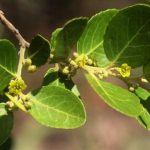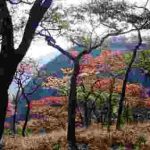TREE LIFE
NOVEMBER 2001
MASHONALAND CALENDAR
Tuesday 6 November Botanic Garden Walk Meet in the car park of the Botanic Garden at 4.45 for 5 pm where we will meet Tom and continue with the Moraceae family.
Sunday 18 November. Our hosts this month in the Darwendale area are Adrian and Debbie Swales. Because of the difficulty in getting round to do a recce, the area chosen by Adrian and Debbie for our walk will be a surprise to us all.
Saturday 24 November Mark’s walk will be in the grounds of the University of Zimbabwe to see what has come up in the burnt patches. This is usually a very rewarding time to see the wild flowers.
We will meet at 2.30 pm in the Vet Science car park which is most easily reached from the UZ gate on Churchill Avenue. Pick up a ticket from the guard at the booms, and drive on for about 500m. The entrance to the car park is the first (and second) turning on the left. To avoid missing the group please be punctual.
Sunday 25 November. Succulent Plant Symposium 8:30 a.m. to 4:30 p.m. There will be nine demonstrations and illustrated talks sponsored by the National Herbarium and The Aloe, Cactus and Succulent Society of Zimbabwe ($100 per person.). For more information and to reserve your place phone 497586 or 494187 or write to 55 Glenara Avenue North, Highlands Harare.
Sunday 2 December 9:30 a.m. to 3:00 p.m. at the National Botanic Garden 5th Street Extension The Aloe, Cactus and Succulent Society of Zimbabwe invite you to a mammoth sale of quality plants at reasonable prices.
Tuesday 4th December Botanic Garden walk
MATABELELAND CALENDAR
The AGM of the Matobo Conservation Society will be held at 15.00 on Saturday 3 November at Camp Amanzi, Shumbashaba Mkulu Farm in the eastern Matopos. For those wishing to share lifts or go in convoy, please meet at the Churchill Arms car park at 14.00. All members of the Tree Society are welcome as the MCS is “caretaking” us. There will be an opportunity for a short walk afterwards, followed by a social braai.
Please bring your own food and drink.
No other arrangements have been made for November. Contact Jonathan Timberlake if you would like to organize a future outing.
WILDLIFE AND ENVIRONMENT ZIMBABWE MANA POOLS ECLIPSE PROJECT: 19 – 23 JUNE, 2001
Team: Mark and Robert Hyde
NARRATIVE:
On both afternoons of 20th and 21st June, 2001, Robert and I were based at the edge of a pan on the north side, near WEZ 2, at UTM position QN 544600.
- On both afternoons a large troop of baboons came down to the pan to eat the Water lettuce (Pistia stratiotes).
- On the control afternoon (20 June), they appeared at 14.45 and slowly moved from east to west along the pan, with many moving out of sight but with some remaining visible when we stopped recording at 16.30. They had all gone by 17.00 when we began the sunset recording session.
- [Although of less interest, on the control afternoon we also kept watch and completed recording sheets for a single elephant and a large number of impala which were moving around in the distance].
- On the eclipse afternoon, the baboons were already at the pan when we started recording at 14.00; this time moving the other way from west to east.
- By the onset of totality, the baboons had been joined by 5 impala and one waterbuck which were all feeding at the edge of the pan.
- Up to the onset of totality, we saw no evidence that any of the species involved were affected by events, despite the strange light and the slight feeling of chilliness. The scene appeared to be totally normal.
- During totality we could not see the animals at all. We did not hear any animal noises from the pan.
- When light reappeared after the 3 minutes, at c.15.15, all the animals had gone! They had all moved c.200 metres to the south of the pan into the Faidherbia (We, and other observers, were all on the north side of the pan. I am fairly sure the animals knew we were there and therefore did not run in that direction).
- It appears that they must have moved silently and rapidly off the pan during darkness.
- Apart from catching odd glimpses of baboons in the distances, we did not see them again. We remained watching at the pan until it became too dark at 18.05 and they did not return
- The impala and waterbuck were visible for a little while longer, although by then they were some way away from us. However, I think they were disturbed by a man and moved out of our sight.
- By 15.35, there were no examples of baboon, impala or waterbuck visible to us, either on the pan or in the woodland to the south.
- Furthermore, none of those animals had returned by sunset.
CONCLUSION: that the eclipse certainly had a dramatic effect on the three species of animal we were observing, namely baboon, impala and waterbuck.
I suppose it is possible that the mass flight of one species might have caused the others to flee as well.
It is a pity we couldn’t see what actually happened during totality.
-M A HYDE
BOTANIC GARDEN WALK THE FIGS (continued)
A very small party (under double figures) met Tom in the Garden on 4 September for the monthly walk in the Botanic Garden to continue the series on the genus Ficus (the figs). This is a somewhat intimidating genus for those, like me, who are not au fait with it, especially as we keep hearing of new spec ies being separated from some that we thought we had known for quite a while. The latest species to emerge from the melting pot is F.rokko, separated from what we had known as F. thonningii (common wild fig). So what English name are we going to get for the new species? ‘Uncommon wild fig’? ‘New common wild fig’?
Unfortunately, Mark was unable to accompany this walk, so I had a go at keeping notes, but I was unprepared for it, and, worse still, my ballpoint pen ran dry halfway through the walk! Hopefully, what follows will be a reasonable account of what we saw and discussed.
The first species we saw on the walk was F. glumosa (mountain rock fig), which we had known as F. sonderi at some time in the past. F. glumosa was at one time thought to be confined to northwestern Namibia – at least in the southern African part of its range – but the botanists had obviously come to the conclusion that our F. sonderi was not separable from it, and the two were merged under the older name.
glumosa is a species of the granite kopjes, where its roots explore the soil between the rocks for water that has been trapped there. It has yellowish bark and markedly rounded, slightly furry leaves. The figs are small, about 10-14 mm in diameter, slightly hairy, and crowded at the ends of the branches. Few of them were ripe, and we were not able to get a good idea of mature colour, but van Wyk & van Wyk has them as red.
Next, we had a brief look at F. natalensis (Natal fig), which, according to the reference books, does not occur in Zimbabwe, but Tom is certain that it does. This has glabrous, somewhat truncated leaves and small, glabrous figs. I’m afraid I did not take particular note of the location of the figs, but the reference books have them as stalked, and in the axils of the leaves.
cordata ssp salicifolia (wonderboom fig) was our next stop. This tree has had a bit of a ding-dong with names over the years – F. pretoriae, F. cordata ssp salicifolia, F. salicifolia, and now back to F. cordata ssp salicifolia. It bears a superficial resemblance to F. ingens, and is occasionally found in granite kopjes. The leaves are noticeably shiny, and the figs are small, and located in the axils of the leaves on the previous year’s wood. The figs may also occur on spurs.
We then had a look at the South African F. cordata ssp. cordata (Namaqua fig) The reference books have the main range of this species in Namibia, but the material in the Botanic Garden came from South Africa. The leaves of this subspecies are smaller than those of ssp salicifolia. The figs are yellowish-green, small, and borne in the axils of the leaves.
The water fig, F. verruculosa, was our next stop, and what we saw was the small Botswana form. The larger Botswana form has been planted at the lake in the Botanic Garden, and this grows up to about 5-7 m, but the smaller form is hardly more than a metre tall, with thin branches. It was growing under fairly heavy shade and appeared to be battling. On our previous Botanic Garden walk, I tried some of the figs of the larger form at the lake, and found them quite tasty – in fact, decidedly moreish!
ottonifolia (?from Zambia) was another small tree, hardly more 1 metre tall. The leaves were still very young, with a line of tiny white spots on either side of the midrib. When this species sheds its branches the scar very quickly heals over. The figs are pendulous, hanging from spurs.
ingens (red-leaved rock fig) is everyone’s favourite, with its reddish-bronze, new leaves at this time of year. The markedly ascending branches make it easily recognisable from a distance. The leaves are fairly similar to those of F. cordata ssp salicifolia, but not quite so cordate, and it has long stipules. The figs are slightly larger than those of other small-fruited species.
The lowveld fig, F. stuhlmannii, has bark strikingly similar to that of the baobab, which is probably quite appropriate. The figs are small, and are borne at the ends of the branches. This tree was almost leafless when we saw it.
Another fig that has had a hard time with name changes is F. lutea (giant-leaved fig), which has spent time as F. vogelii, F. nekbuda, and F. quibeba. This tree was also almost leafless, but it had very large new stipules.
We saw F. craterostoma (rare forest fig) in passing, as this had been dealt with on an earlier visit. This species has markedly truncate leaves.
The swamp fig, F. trichopoda, was our next stop. This is a coastal species from Mozambique and South Africa, where it occurs in marshy areas almost to sea level. It does not occur in Zimbabwe at all. The leaves are heart-shaped and very large.
Finally, as the light was fading fast, we had a quick look at F. cyanthistipula, a species from Zambia. This has large figs with white spots on the skin. The leaves have quite a noticeable drip-tip, indicating that the species occurs in areas of high rainfall.
BOTANIC GARDEN WALK: 2 OCTOBER 2001
Today we looked at further species in the fig family, namely some mostly non-Zimbabwean species of Ficus and some trees which belong to other genera in the same family of Moraceae.
To start with the latter first, Tom pointed out to us a species called Treculia africana. In the Flora Zambesiaca (FZ) area it occurs in Malawi, Mozambique and Zambia, but not Zimbabwe. It occurs in riverine vegetation (for example the Zambezi delta) where it can be a huge tree (to 50 m per FZ).
According to FZ, the inflorescences are quite large (2.5-10 cm in diameter) dense, spherical but in fruit they expand to as much as 30 cm in diameter. These are borne in the leaf axils or on the older wood down to the trunk. (In that respect, they are reminiscent of Artocarpus utilis, the Jack fruit, which is an exotic species also from the Moraceae). The tree is usually dioecious so separate sexes would occur on separate trees.
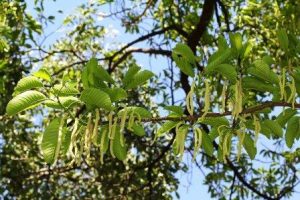
Milicia excelsa. Photo: Bart Wursten. Source: Flora of Zimbabwe
The other species seen was Milicia excelsa (formerly known as Chlorophora excelsa). Although it is widespread in Africa, it is a rare species in Zimbabwe, more or less confined to the Rusitu valley and by the Runde River in Gonarezhou National Park. It is a large tree, occurring in riverine and other types of forest. This is another dioecious species; both the male and female inflorescences consist of catkin-like spikes. These (males?) were present on the trees we looked at.
Next to the pond was a species of fig, Ficus cyathistipula, which formed a dense cover to the ground (“an opportunity for lovers” – remarked Tom). The leaves are large and obovate with an acuminate tip and the species bears large and rather puffy figs. This is another widespread species in Africa, e.g. in Malawi and Zambia, but does not reach Zimbabwe; it occurs in riverine and swamp forest and on rocks and by river banks.
Another species seen was Ficus trichopoda (formerly F. hippopotami), the swamp fig. This is another species of wet places – swamp forest, river banks, vleis and swamp grassland. Although recorded from most of the countries around us, it does not occur in Zimbabwe.
Finally, a Zambian species, Ficus dicranostyla. This has a noticeable yellowish bark and medium-sized, greenish-yellow figs,
Unfortunately, I had to leave the walk early, so this is a slightly truncated account. Once again, our thanks go to Tom for so kindly leading us.
-Mark Hyde
THE SAUSAGE TREE
The note on pollination of the sausage tree, which appeared in TREE LIFE 260 (October 2001) had me reaching for DJ Mabberley’s The Plant-Book to see what might be written there on the subject. My copy of the book is a 1993 edition, and Mabberley still had the species as Kigelia pinnata, with Kigelia africana as a synonym. All other reasonably recent reference works indicate that Mabberley was wrong on that score. However, he has Kigelia as a genus of only one, variable species from tropical Africa, and a check in Dale & Greenway (1961), Kenya Trees and Shrubs reveals that three species were recognised in Kenya at the time of publication – K. aethiopum, K. moosa, and K. pinnata. This probably takes care of Mabberley’s “variable species”, but there is no mention in Dale & Greenway of pollination agents. Here, Mabberley states positively that Kigelia is bat pollinated – presumably meaning in its natural environment – and it was very interesting to read in the article reproduced from the Fairchild Tropical Garden Bulletin, that in Florida a bird, the Spotted Breasted Oriole, has successfully taken over the job.
If any member of the Tree Society has a copy of Flora Zambesiaca, Vol 8(3), 1988, which contains the Bignoniaceae, it would be worth checking to see whether Mabberley is right in stating that there is only one species in Kigelia, and whether there is any mention of pollination agents.
-Lyn Mullin
TENNESSEE RANCH RAFFINGORA
On Sunday 16 September at least 20 avid tree watchers converged on the home of Dave and Colleen Duffield on the Rafingora Road.
After a sumptuous tea, our dusty caravan of ‘pick-ups’ undulated their way onto Dave’s ‘Tennessee’ ranch. The journey ended in a well ‘ treed’ area at the base of one of the imposing line of granite ‘gomos’ that run along the northern side of Masvikudai Dam.
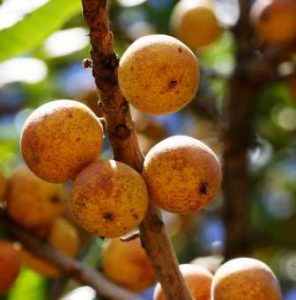
Uapaca kirkiana. Photo: Bart Wursten. Source: Flora of Zimbabwe
It is at this point that the crunching started; a sure indicator of what could be identified over-head. We had found ourselves in a well grown stand of Uapaca kirkiana (Mahobohobo) in their male and females forms with the latter bearing a budding crop of spherical fruit. The fruits, when ripe, are extremely edible and when fermented are reputedly ‘imbibable’. In the vicinity Uapaca nitida were also spotted; the poor relation with smaller leaves and not so tasty fruit.
Having scanned the main canopy we were quick to notice a reticent flush of pink against the ridiculously blue sky. A slim but attractive version of Stereospermum kunthianum (Pink Jacaranda) was in flower. Nearby grew a Diospyros natalensis (Small-leaved jackal-berry or Ticky tree) with its many slender branches and small neat rounded leaves. These characteristics make it an attractive species to bonsai.
It was noticed that these two species were located in their ideal growing conditions. These being close proximity to granite which means maximum rain water run-off and being near to termite workings which increases aeration and the nutritional content of the soil.
During the morning a number of examples of another species that enjoys moist soils and termite mounds were seen; namely Gardenia ternifolia. Evidently this species is often encouraged to grow near rural homes to protect the occupants from lightning strikes and attacks from evil spirits. A couple of these trees boasted aging white flowers and ovoid fruit along with their ‘test- with- your- tongue’ slightly hairy leaves. Our tongues were challenged once again when they had to get around the name Bequaertiodendron magalismontanum (Stem Fruit). The fruit of this tree is claimed to be enjoyed by all and although it is slow growing it’s attractive evergreen appearance is favoured by landscapers.
It seemed, in fact, that there was something for everyone in this small area of woodland:
– Baboons and bees are said to be the fans of the Bauhinia petersiana subsp. macrantha. The former eat the bark and the latter enjoy the flowers. – Antidesma venosum could be called ‘bird supermarket’ with its plentiful fruit (in March-May) at varying stages of ripeness to suit all tastes.
Pleurostylia africana with its light green, slightly wavy-margined leaves has been known as ‘insect heaven’ when in flower.
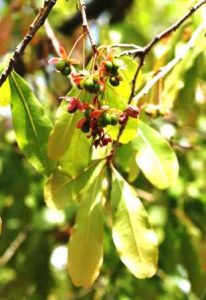
Ochna schweinfurthiana. Photo: Petra Ballings. Source: Flora of Zimbabwe
The tick-like fruit in the persistent sepals of’ Ochna gambleoides and Ochna schweinfurthiana are eaten by birds. At this time of the year, Rhus longipesis is clothed in lovely, light, fresh green leaves (3-foliolate and petiolule on terminal leaf). Its multi-branching growth is ideal for nesting birds.
The nut of the fruit of Ximenia americana is rich in oil and can be extracted to make ‘indigenous candles’
No doubt many creatures would be enjoying the spring flowering of a number of the trees including Faurea saligna, and Paranari curatellifolia.
Climbing the hill we identified a wonderful example of Sterculia quinqueloba and coming into leaf were Brachystegia glaucescens and Brachystegia boehmii. Fortunately, we did not witness the 12 ft Mamba in its new foliage; the only evidence of its metamorphosis was its skin which was dutifully admired. For those whose pulse was not quickened by the prospect of meeting a snake or by a climb, the appearance of Acacia goetzii subsp. microphylla on the flat seemed to hit the spot!
Other trees listed for the day were :
Syzygium guineense subsp. guineese, Cussonia arborea; Pterocarpus angolensis; Strychnos innocua (at the base of which was growing a bawdy-crimson wild hibiscus flower); Ficus sur; Ficus thonningii; Pappea capensis; Zanha africana; Dombeya rotundifolia and Terminalia sericea.
Finally, the highlight of the post-luncheon-perambulation were two white faced owls. They looked down, momentarily, on our straggly group, then resumed their closed-eyed, long-eared stance of disinterest; we were not a species that they had any desire to pick, press or identify!
-Pippa Browne
TREES AND BEES
At the Tree Society field day at the Duffield’s Nkwodzwi Farm in Raffingora on 16 September 2001, I made comments from time to time on the importance to beekeepers of some of the trees we saw. Maureen subsequently asked me to submit some notes on the subject for Tree Life.
Honeybees collect their food requirements from plants using nectar from which they make honey as their energy requirements, and pollen for their protein requirements.
The average composition of honey made from nectar collected from floral nectaries is as follows:
Fructose 41.0%
Glucose 35.0%
79.4% overall sugars
Sucrose 1,9%
Dextrin 1,5%
Water 17,0%
Minerals (ash) 0,2%
Undetermined 3,4%
It is the 3,4% “undetermined” which gives honey its characteristic flavour and aroma, and as such is very important to the beekeeper.
Honeybees will selectively forage on flowers producing high concentrates of sucrose which, with the addition of enzymes produced by themselves, they convert to monosacharide sugars, fructose and glucose during the honey production process.
At this stage, it is of interest to look at something of an anomaly. On the Raffingora field day one of the trees we looked at was Faurea saligna, an important bee tree and used as a source of honey in the Transvaal bushveld and lowveld. The honey is reported to be “dark red-brown in colour, has a strong malty flavour and somewhat musty aroma”. Little pollen is collected by honey bees. Where the anomaly comes in is in the sugar content of the floral nectar, which is high in the pentose sugar, xylose. Xylose has recently been reported as a major sugar in the nectar of Protea and Faurea.
Interestingly, xylose is unattractive to honey bees and cannot be metabolized by them, and high concentrations may affect the osmotic physiology of the bees. Apparently there is at present no known ecological explanation for the presence of xylose in the nectar of Protea or Furea. It has been theorised that as insect pollinators receive no benefit from the xylose component of the nectar they will have to spend more time on the flowers to meet their energy needs. These extended foraging times may improve pollination.
Another tree we looked at in Raffingora was the water berry Syzygium guineense (I don’t think we decided which subspecies). This is a very useful bee tree but I can find no references to its honey characteristics. However, an Asian species, Syzygium cumini produces a light reddish honey with a distinctive, pungent/bitter taste which limits its consumption, except that it is considered as possessing medicinal properties for any stomach disorders and the relief of toothache. It is also used as an ingredient for liquor distillation.
My final tree for this article is Ziziphus mucronata which produces a light amber honey of good flavour. A Ziziphus species of great interest to beekeepers is the middle eastern Z. spinachristi. The name spinachristi derives from the belief that Jesus Christ was crowned with the branches from this Ziziphus. This tree produces one of the most famous and expensive honeys in the world. Considered holy by the Islamic people, this honey is a product of Eritrea and Yemen and goes by the name of “siddr”.
Z. spinachristi has been introduced and naturalised in many tropical countries, mainly for its edible fruit.
Peter Taylor.
BEAUTIFUL BUT DEADLY
The Mediterranean olive becomes a dangerous pest.
By Leila Moseley and Adam Piore in the ecology section of News Week September 3rd 2001
In ancient times, to eat an olive was to touch the gods. The Greeks believed it was Athena, goddess of wisdom and war, who gave mankind the divine fruit. They used it to anoint their bodies. The Romans, too, coveted the precious crop, and later the Venetians, who shipped it around the Mediterranean from Palestine to Morocco and Spain. Civilizations have changed but not our appetites. We moderns cherish the olive for our health, a staple of garden salads and organically correct cooking. But while the olive may be good for body and soul, it turns out it isn’t so good for the land.
Environmentalists warn that humanity’s love for olives may be dangerously misplaced. Yes, few things are quite so pleasant as a drive along the coasts of Portugal or Greece, where the land is rich with olive groves, leaves shimmering in the wind. But truth be told, Homer’s sylvan glades are becoming something of a pest. In recent decades a growing number of farmers (not to mention rapacious multinational agro-conglomerates) are mass-producing the once rare tree. All around the Mediterranean, huge olive plantations are sucking the soil dry, depleting nutrients, producing near-deserts and endangering indigenous flora and fauna. If the trend continues, predicts Richard Perkins of the Worldwide Fund for Nature, “the future will be a poisoned environment”.
The problem grows from a very modern root: European Union subsidies. Olive grants make up 7 percent – or US$2 billion – of the EU’s Common Agricultural Policy. Because the system rewards farmers on the basis of how much they produce, they have every incentive to overplant. The more they plant, the more money they make. The result, from Tuscany to the Peloponesus: Olives R Us. Damaso Gonzalez, an olive farmer in Campo Real, outside Madrid, puts it baldly. He has planted 1,500 new olive trees over the past four years. “The EU subsidy is very important”,’ he says. “Otherwise, this business would not be profitable.”‘ The environmental impact is proving calamitous. In Spanish Andalusia, so many olives have been planted (destroying ground cover) that topsoil now just blows away – 80 million tons a year. The Guadalquivir river basin – a famed wildlife haven in southern Spain – has been almost diverted into olive groves, destroying animal habitats for everything from quail to the near-extinct Iberian lynx. Pollution is rampant, due to the heavy use of fertilizers and pesticides, while traditional woodlands and fields give way throughout the region. “Where you once saw vineyards, you now see olive trees,” laments Nikos Papadontonakis, agricultural specialist with the Mediterranean Agronomic Institute on the island of Crete.
Little relief is in sight. EU Agricultural ministers recognized the growing problem as early as1998. But proposals to modify the debilitating subsidy system have gone nowhere, and recently Mediterranean growers successfully lobbied to put off any talk of reforms until at least 2003. Meanwhile, olives continue their inroads. How ironic. The very embodiment of our Greco-Roman civilization, now a destroyer.
MARK HYDE CHAIRMAN


